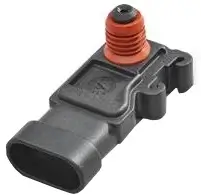What are the symptoms of a bad MAP sensor
Here are the 6 most common symptoms of a bad MAP sensor
A bad MAP sensor can cause any or all of the following:
Hard start or no start
Engine starts and then stalls
Car hesitates or drags while under load or idle.
Car hesitates or jerks during acceleration.
Ping or detonation
Excessively rich or lean idling along with poor gas mileage
Check engine light or failed emissions test
Common MAP sensor trouble codes
P0068: MAP/MAF – Throttle Position Correlation
P0069: Manifold Absolute Pressure – Barometric Pressure Correlation
P0105: MAP Circuit Malfunction
P0106: MAP/Barometric Pressure Circuit Range/Performance Problem
P0107: Manifold Absolute Pressure/Barometric Pressure Circuit Low Input
P0108: MAP Pressure Circuit High Input
P0109: MAP / Baro Pressure Circuit Intermittent
P1106: MAP/BARO Pressure Circuit Range/Performance Problem
P1107: Barometric Pressure Sensor Circuit Low Voltage
How a bad MAP appears on scan tool data
Since the MAP sensor reading are used to calculate air/fuel settings, a bad MAP can cause either a lean air/fuel reading or rich air/fuel reading on a scan tool.
Symptoms of a lean air/fuel ratio
A lean air/fuel ratio would cause surging, stalling, a lack of power, hesitation on acceleration, engine overheating and backfire. A lean air/fuel ratio would cause the long-term fuel trim to be above 10% as the computer tries adding fuel to compensate
Symptoms of a rich air/fuel ratio
A lean air/fuel ratio would a rough idle, poor MPG, slow acceleration, gas smell at idle. A rich air/fuel ratio would cause the long-term fuel trim to be -10% to-25% as the computer subtracts fuel to compensate
What causes a MAP sensor to fail
MAP port contamination and clogging
MAP sensors can be damaged by contamination and clogging. Check for a plugged port to the intake manifold or a plugged port to the atmosphere.
MAP sensor seal or hose deterioration
If the MAP sensor is pressed into the intake manifold, check the silicone seal to make sure it’s intact. If the seal is cut, torn or deteriorated, it can cause
Electrical connector issues
Corrosion and overheating can cause the electrical connections to fail.
Diagnose a bad MAP sensor
Tools you’ll need: Multimeter and a hand held vacuum pump
1) With the battery on and engine off, connect the multimeter  ground to the negative battery terminal and touch the positive lead to the positive terminal of the battery. It should be around 12.6 volts. Do this prove the battery is fully charged.
ground to the negative battery terminal and touch the positive lead to the positive terminal of the battery. It should be around 12.6 volts. Do this prove the battery is fully charged.
2) Consult a shop manual wiring diagram for the wire colors and connector pinout for the MAP sensor to identify the signal, ground, and 5-volt reference.
3) Turn the ignition switch to the RUN position, but don’t start the engine. Use your multimeter to check for reference voltage (typically between 4.5 to 5 volts), ground voltage (a steady 0 volts), and between 0.5 and 1.5 volts for the signal wire on non turbo applications and between 2.0 and 3.0 for turbo applications. Compare the results to the specs in a shop manual.
4) With the multimeter connected to the signal wire, start the engine. The multimeter reading should be .5 to 1.5 volts at sea level on non turbo charged vehicles and 2.0 to 2.5 volts on turbocharged models. Turn off engine.
5) Turn the key to the RUN position but don’t start the engine. Disconnect the MAP sensor from the intake port and connect a hand vacuum pump to the portion that fits into the intake. Increase the vacuum on the sensor using the vacuum pump while watching the voltage on your meter. The voltage should steadily drop as the vacuum increases.
If any of the voltage values are out of spec, the problem is a bad MAP or a wiring harness issue.
©, 2023 Rick Muscoplat
